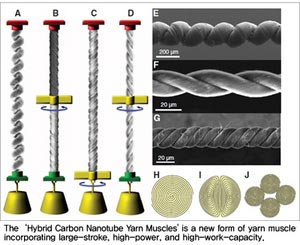Hybrid Carbon Nanotube Yarn Muscle

<br>
Kim’s article, “Electrically, Chemically, and Photonically Powered Torsional and Tensile Actuation of Hybrid Carbon Nanotube Yarn Muscles,” was published in the journal of Science. He is currently the director of the National Creative Research Initiative Center for Bio-Artificial Muscle at Hanyang University (HYU). In 2006, the research center was designated as the “Leader’s Research Support Business” by the Ministry of Education, Science, and Technology.
Traditional methods of electrochemically powered yarn muscles were destined to include slow responses, low strain and force generation, a short cycle life, and low energy efficiency. They were also in need of electrolytes, counter electrodes, and device packaging. Such requirements increase the weight of the actuator leading to a decrease in performance.
The ‘Hybrid Carbon Nanotube Yarn Muscles’ created by Kim however, has overcome such limitations by confining paraffin waxes, a thermally or electrothermally powered actuators, within the yarn. By doing so, the response rate is enhanced and a helical geometry enables both torsional rotation and tensile contraction.
Muscle contraction – also called actuation – can be ultrafast, occurring in 25-thousandths of a second. Including times for both actuation and reversal of actuation, the researchers demonstrated a contractile power density of 4.2 kW/kg, which is four times the power-to-weight ratio of common internal combustion engines.
Application of the ‘Hybrid Carbon Nanotube Yarn Muscles’ are diverse because the yarn muscles can be twisted together and are able to be woven, sewn, braided and knotted, they might eventually be deployed in a variety of self-powered intelligent materials and textiles. For example, changes in environmental temperature or the presence of chemical agents can change guest volume; such actuation could change textile porosity to provide thermal comfort or chemical protection. Such yarn muscles also might be used to regulate a flow valve in response to detected chemicals, or adjust window blind opening in response to ambient temperature.
Kim stated, “The ‘Hybrid Carbon Nanotube Yarn Muscles’ is a new form of yarn muscle due to its torsional rotation and tensile contraction which functions in an electrolyte-free environment.” In addition, “Its simple operating method and structure will have a big impact on the motor, biological, and robot industry.”
Article written by Jisoo Lee: themanjsl@hanyang.ac.kr
Media Contact
All latest news from the category: Interdisciplinary Research
News and developments from the field of interdisciplinary research.
Among other topics, you can find stimulating reports and articles related to microsystems, emotions research, futures research and stratospheric research.
Newest articles

Parallel Paths: Understanding Malaria Resistance in Chimpanzees and Humans
The closest relatives of humans adapt genetically to habitats and infections Survival of the Fittest: Genetic Adaptations Uncovered in Chimpanzees Görlitz, 10.01.2025. Chimpanzees have genetic adaptations that help them survive…

You are What You Eat—Stanford Study Links Fiber to Anti-Cancer Gene Modulation
The Fiber Gap: A Growing Concern in American Diets Fiber is well known to be an important part of a healthy diet, yet less than 10% of Americans eat the minimum recommended…

Trust Your Gut—RNA-Protein Discovery for Better Immunity
HIRI researchers uncover control mechanisms of polysaccharide utilization in Bacteroides thetaiotaomicron. Researchers at the Helmholtz Institute for RNA-based Infection Research (HIRI) and the Julius-Maximilians-Universität (JMU) in Würzburg have identified a…



